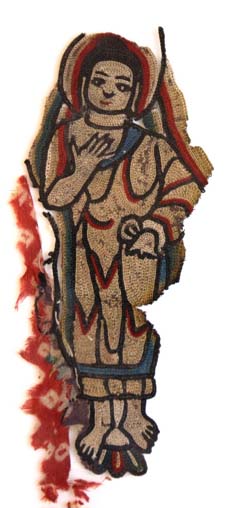
Embroidered Buddha, Banner Fragment, 7th-8th century, silk, from Toyuk, Xinjiang, China
Asian Art Museum, Berlin (III6178)
A “Devotional Form of Art:” Developing and Recycling Textiles Along the Silk Road, Dunhuang Foundation
Online talk, February 24, 2022, 7pm EST
The Dunhuang Foundation hosts a lecture by Mariachiara Gasparini, Assistant Professor of Chinese Art and Architectural History at the University of Oregon, that explores the processes involved in developing and recycling textiles in the western regions of China, beyond the main Silk Roads. During the Tang period (618–907), through a system of intra- and extra-monastery circulation of goods, high-ranking officials “sacrificed” some of their wealth in support of Buddhist communities. The gongde, literally ‘merit’ and ‘achievement and virtue,’ was applied to all kinds of Buddhist activities, including the redistribution and circulation of these “gifts.” Among the many goods that were offered and recycled, textiles provided Buddhist communities with various patterns and motifs – many of which were acquired from Turko-Iranian communities – that enabled the Sinicization of Buddhist art and its diffusion in East Asia.
The Dunhuang Foundation, founded in the U.S. in 2010, builds upon Dunhuang's rich legacy of intellectual and cultural exchange through programs that encourage participants to explore and expand upon the site's rich histories. The organization regularly organizes lectures by specialists conducting important research relevant to the study and understanding of Dunhuang. Recordings of previous lectures are available on the Foundation's website, click here.
For more information about Professor Gasparini's lecture and to register, click here
